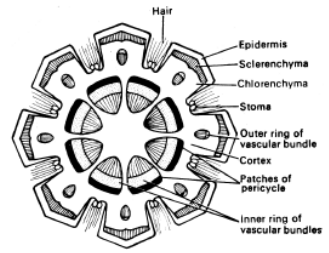
Characteristics Of Xerophytes
Organisms And Their Environment of Class 12
Characteristics Of Xerophytes
They are described under two headings—
- Morphological features
- Anatomical features
Morphological Features of Characteristics Of Xerophytes
Roots
In contrast with hydrophytes which develop in conditions with plenty of water, xerophytes develop under water deficient conditions. Thus, in order to secure water, which is present in less amount and, moreover, in deeper layers of soil, in xerophytes roots become the principal organs of primary importance.
The root system is thus very well developed, with the following characteristics:
- It is very extensive, which in some cases is several times longer than the shoot. Roots are long, tap roots, with extensive branching spread over wide areas.
- Root hairs and root caps are very well developed.
Stems
Mostly they are stunted, woody, dry, hard, ridged and covered with thick bark. In some case such as Saccharum , stem becomes underground, whereas in Opuntia it becomes fleshy, green, leaf like (phylloclade) covered with spines, in Euphorbia also it becomes fleshy and green.
On stems and leaves there are generally hairs ( e.g. , Gnaphalium, Aerua, Calotropis) and/or waxy coating.
Leaves
Leaves are very much reduced, scale like appearing only for a brief period, sometimes modified into spines. Lamina may be long, narrow or needle like as in Pinus or divided into many leaflets as in Acacia.
Foliage leaves, wherever present, may become thick, fleshy and succulent, or tough and leathery in texture. Leaf surfaces are generally shiny and glazed to reflect light and heat ( e.g. , Nerium ). In some non succulent xerophytes, particularly grasses as Ammophila, Poa, and Agropyron , leaves become folded and rolled in such a manner that the sunken stomata become hidden, and thus rate of transpiration is considerably minimized (i.e, their epidermal cells renwin mostly turgid).
In some of them as Euphorbia, Acacia nilotica, Zizyphus jujuba and Capparis aphylla, stipules become modified into spines.
Anatomical Features of Characteristics Of Xerophytes
Roots
Roots hairs and root caps are well developed. In Opuntia , roots hairs develop even at the root tips. Root may become fleshy to store water as in Asparagus . In Pinus edulis and Calotropis , roots possess rigid and thickened walls.
Stems
In succulent xerophytes, stems possess a water storage region.

Fig. : T.S. of stem of Casuarina
- Cuticle is very thick.
- Epidermis is well developed, with heavily thickened cell walls.
- Hypodermis is several layered and sclerenchymatous.
- Stomata are of sunken type.
- Vascular tissues are very well developed, differentiated, heavily lignified. Vascular bundles have well developed several layered bundle sheaths.
- Mechanical tissues are very well developed.
- Bark is very well developed.
- Oil and resins are often present.
- Proline is useful in maintaining osmotic and water potential.
- Chaperonins are heat shock proteins which protect other proteins from denaturisation at high temperature.
Leaves
In succulent leaves of melacophyllous xerophytes, such as Peperomia , epidermal cells of leaves serve as water storage organs. Similarly, succulent leaves of Aloe and Salsola have prominent water storage regions in their mesophyll. Moreover, in such leaves cuticle is thick and outer walls of the epidermal cells are heavily deposited with cutin and cellulose.
Leaves of non succulent xerophytes, such as Nerium and Pinus etc. possess:
- Well developed heavy cuticle.
- Several layered epidermis in Nerium, and several layered, sclerenchymatous hypodermis in Pinus.
- Mesophyll very well differentiated into palisade and spongy parenchyma.
- Stomata of sunken type confined only to lower epidermis. In some xerophytes as Nerium, stomata are situated in pits lined with hairs.
- Vascular tissues very well developed, differentiated into xylem with lignified elements, and phloem. In Nerium,in addition to big vascular bundle in mid rib region, there are several other vascular bundles also.
- Mechanical tissues very well developed, including several kinds of sclereids. In Pinus, there is well developed complex transfusion tissue.
Also Check






